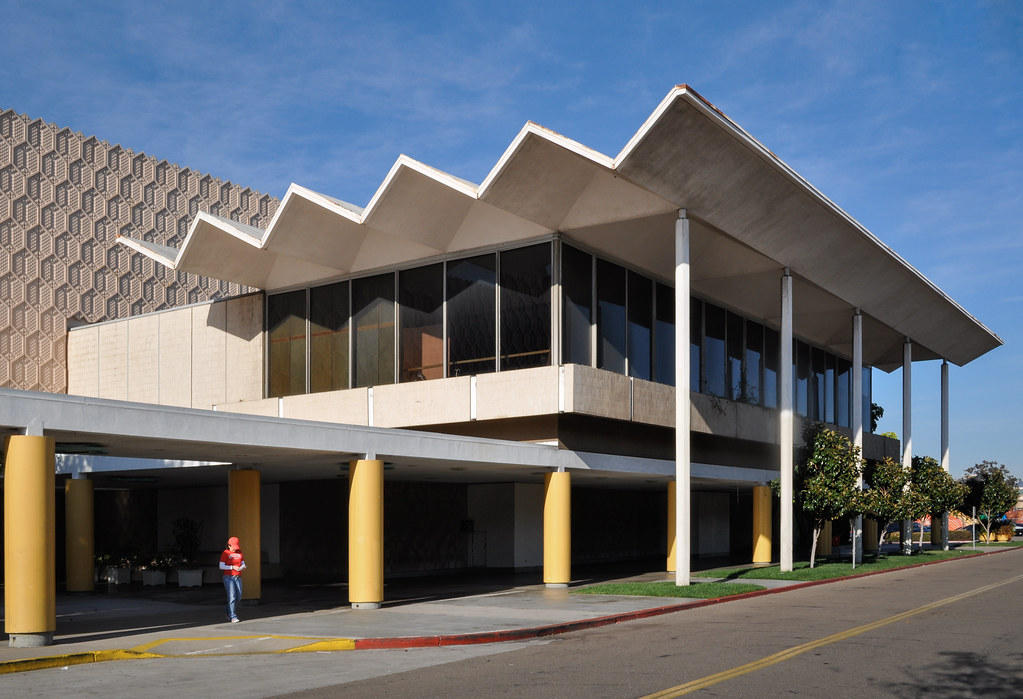 |
| The former restaurant of what was once May Co. department store at Mission Valley Center. Photo ©Darren Bradley |
Anyone who's ever spent any time in San Diego will probably recognize this place. It's hard to miss. This Macy's department store at Mission Valley Center is strikingly clad entirely in formed concrete hexagons around its entire exterior. Even cooler, there's a cantilevered glass box attached to the south side, closest to the freeway, with a great bi-fold roof. The building has anchored Mission Valley Center since 1961, and it's become a landmark in the city. But with Macy's closing, its days may now be numbered...
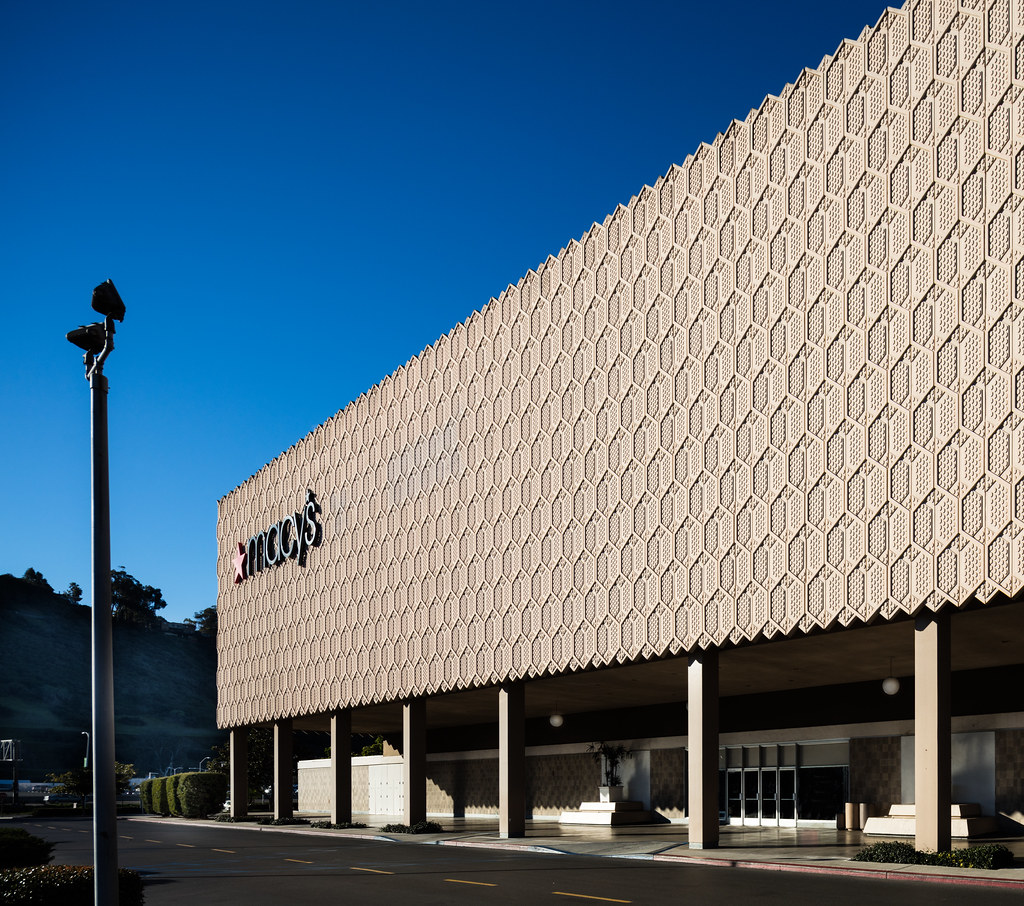 |
| The east side of the Mission Valley Macy's, looking south. Photo ©Darren Bradley |
With Macy's suffering like so many department stores and shopping malls around the country in the internet age, they've decided to close 68 stores around the country. This is one of them. Macy's have sold the building to Westfield, who own the shopping center it's attached to.
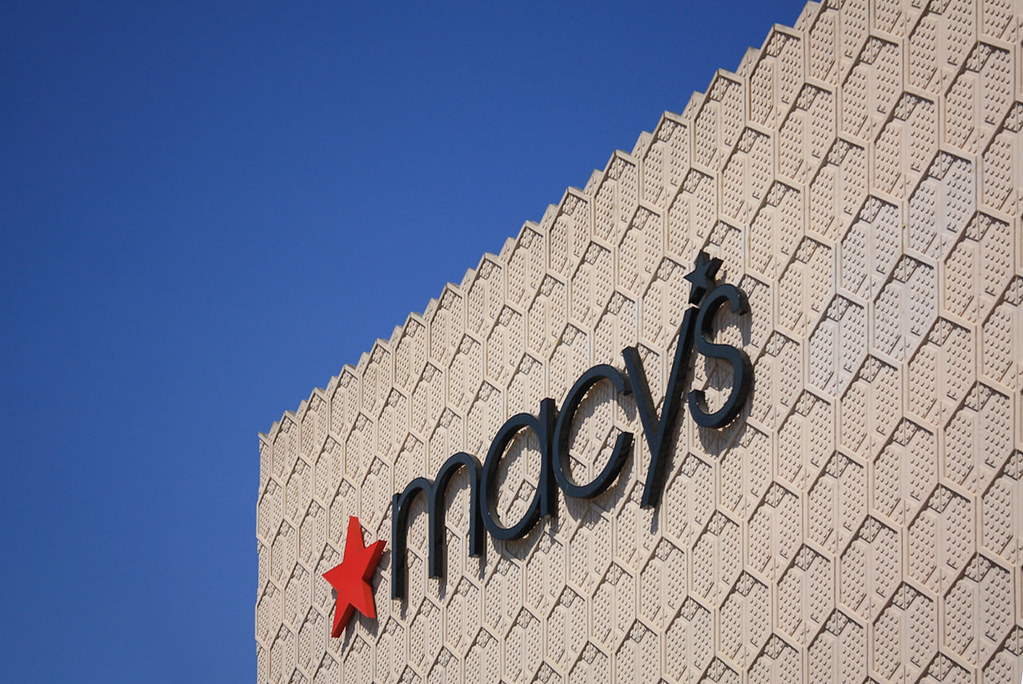
Now, there is some hope, because the attached mall - Mission Valley Center - has more or less maintained its original mid-century modern character. But the mall lost a fair amount of its character back in 1994 when it was acquired by the Australian mall giant, Westfield, and they covered over the original garden courtyard to add a restaurant space.
They also did a cheap remodel of the buildings at the time which, ironically, made the them look more like new buildings that were trying to appear mid-century modern than actual mid-century modern. Strange, since it seems like it would have been better to just try to maintain the mall's original mid-century modern character. I guess people liked the kitschy, pretend version more than the real thing...
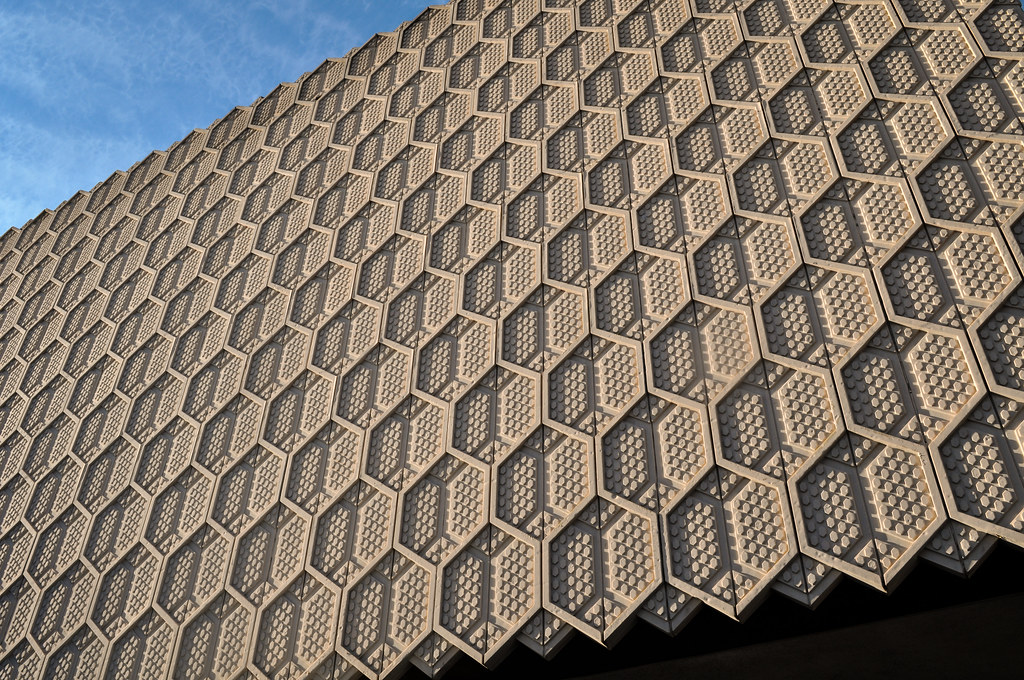 |
| That cladding, though... Photo ©Darren Bradley |
Anyway, this Macy's store managed to escape those bad remodels because it was still owned by Macy's, and wasn't sold to Westfield previously when the rest of the mall was acquired. But now, Westfield has finally bought this building, as well.
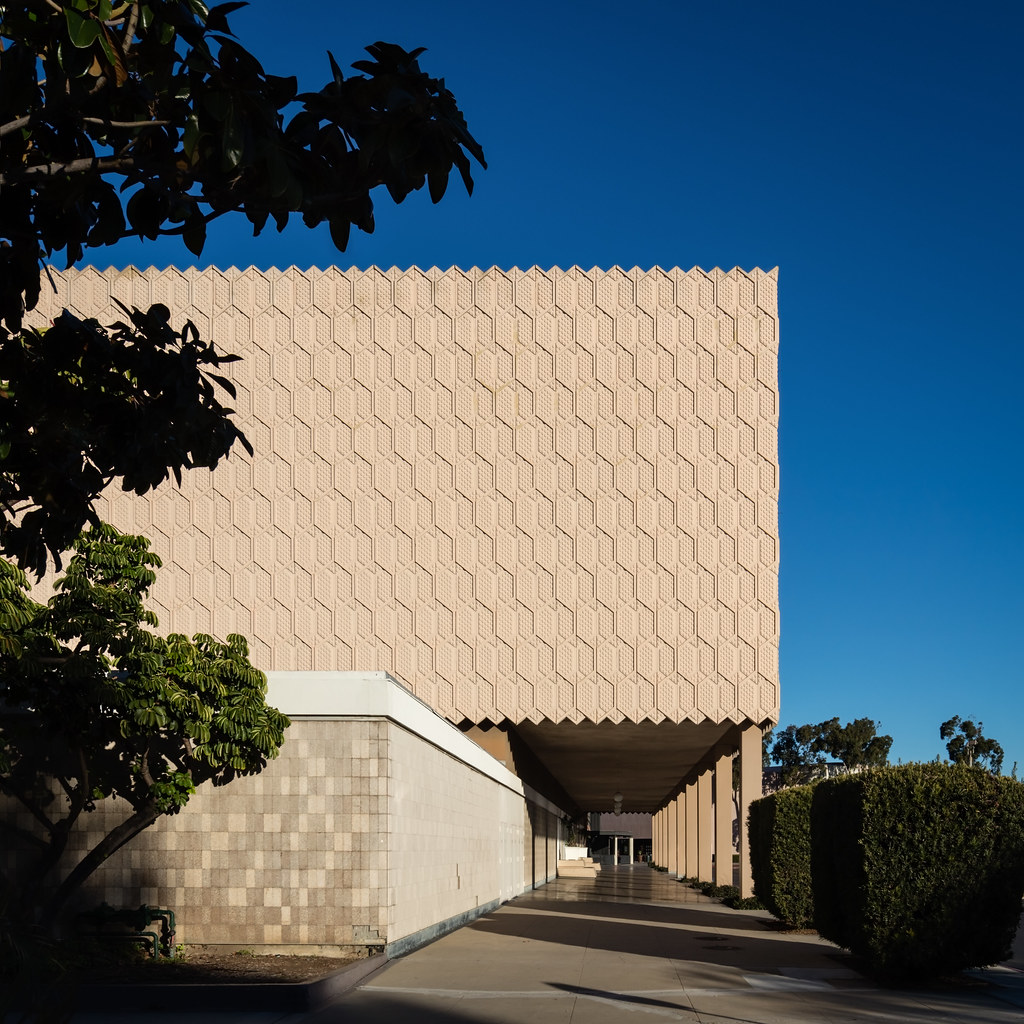 |
| Mission Valley Macy's. Photo ©Darren Bradley |
Given the decline of department stores and the unlikelihood of finding another suitable tenant who will want to acquire such a large, three-storey retail space with almost no windows... it's difficult to imagine this building surviving intact.
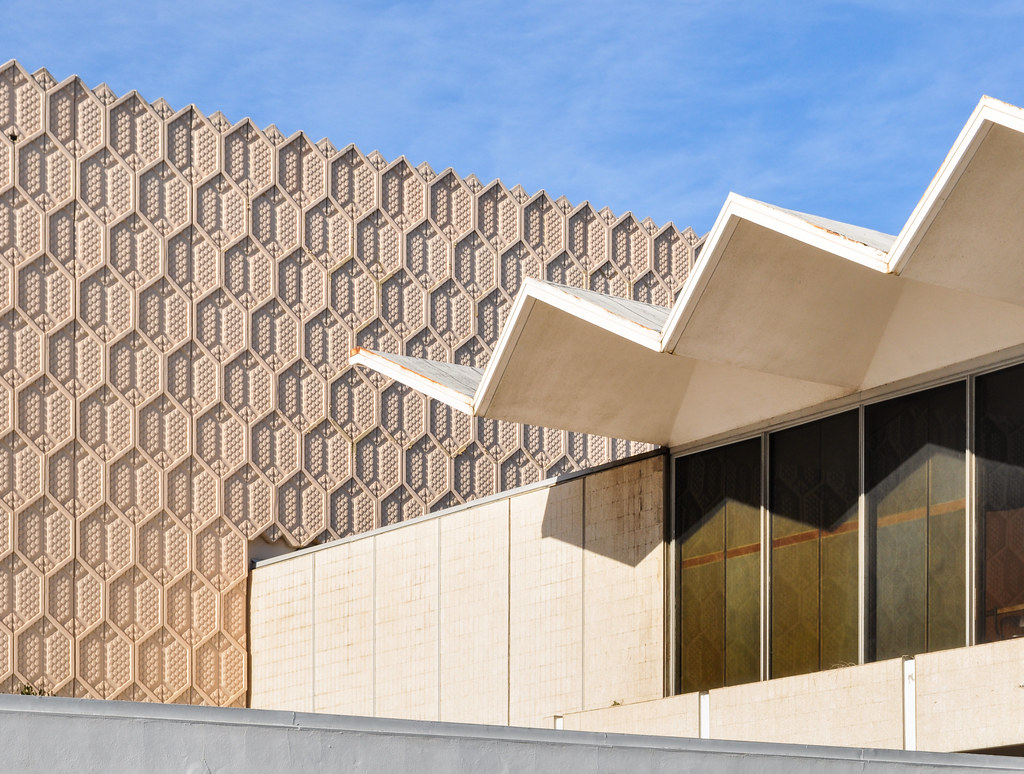 |
| Detail of the Mission Valley Macy's. Photo ©Darren Bradley |
Mission Valley Center was San Diego's first suburban, regional shopping center. Back in the late 1950s, Mission Valley was nothing but farmland and cow pastures.
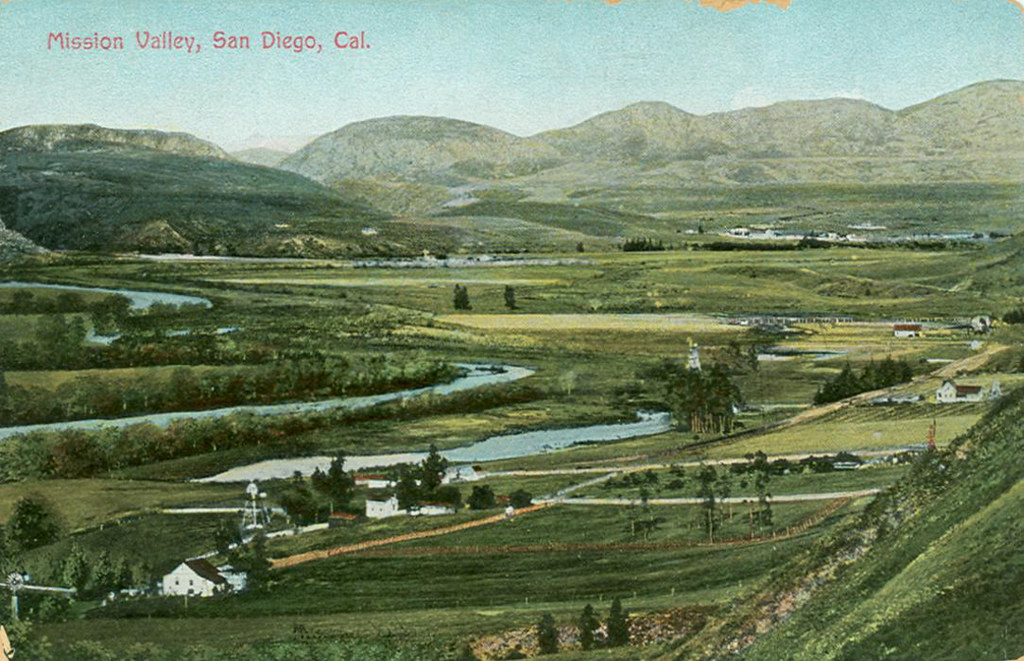 |
| San Diego's Mission Valley looked like this into the 1950s. |
Because it is adjacent to the San Diego river, and prone to unpredictable flooding, this land had been largely passed over for development until the 1960s.
But when US Route 80 came in, and became Interstate 8 in about 1959/60, lots of infrastructure and flood control was promised, which finally made the land there attractive to developers.
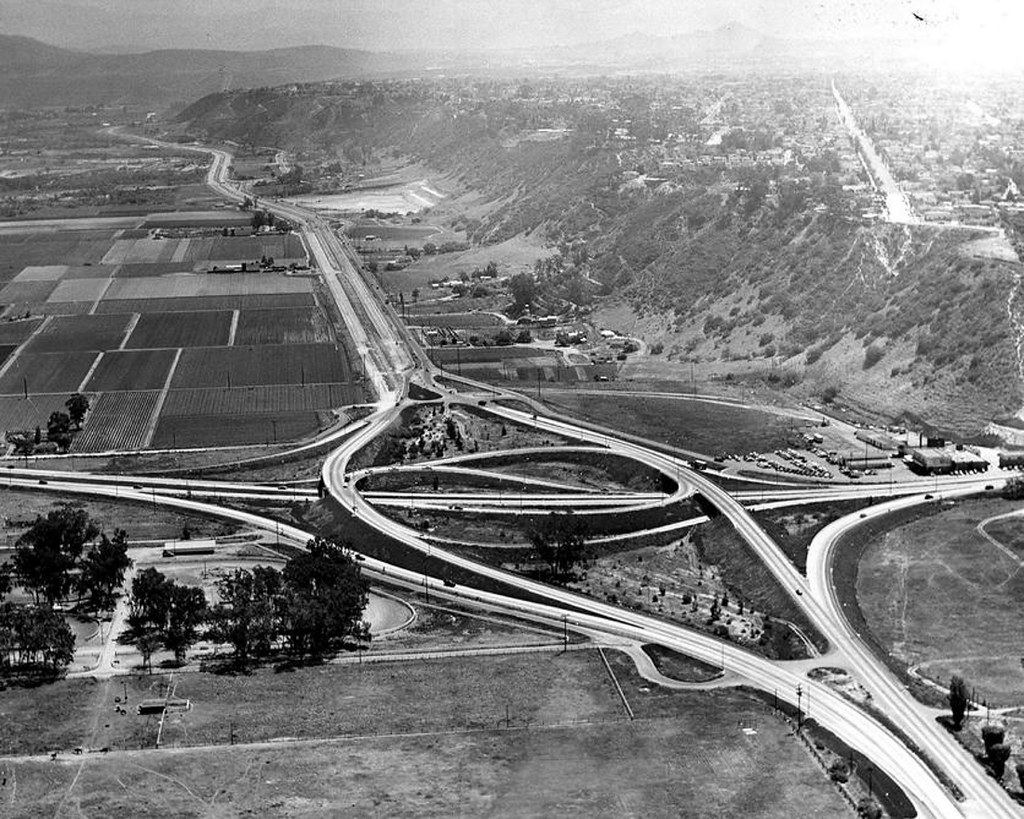 |
| The freeway interchange for Interstate 8 and Interstate 15, around 1960. |
The developers for Mission Valley Center spared no expense. That included hiring one of the largest and most reputable architecture firms from Los Angeles, A.C. Martin, to design their mall. They brought on a local San Diego firm, Frank L. Hope & Associates, to backstop the project (Frank L. Hope was perhaps the largest San Diego firm, and they went on to design the San Diego Stadium and many other prestigious projects in town).
At AC Martin, the task fell to a talented lead designer named Bill Lewis. While designing this project, Lewis and colleague Ward Deems decided to relocate to San Diego permanently. They set up shop in San Diego, with AC Martin's blessing and support. Mission Valley Center, including this Macy's (originally built as a May Co. store) became the first project of a partnership that would go on to design many San Diego landmarks.
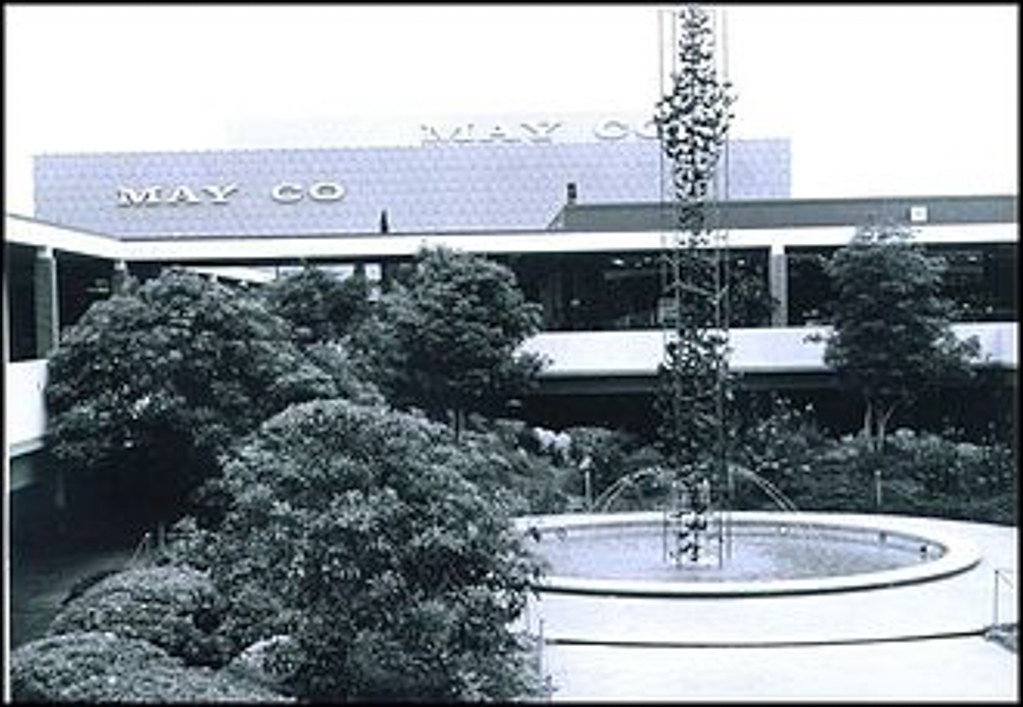 |
| Mission Valley May Co., now a Macy's Store. |
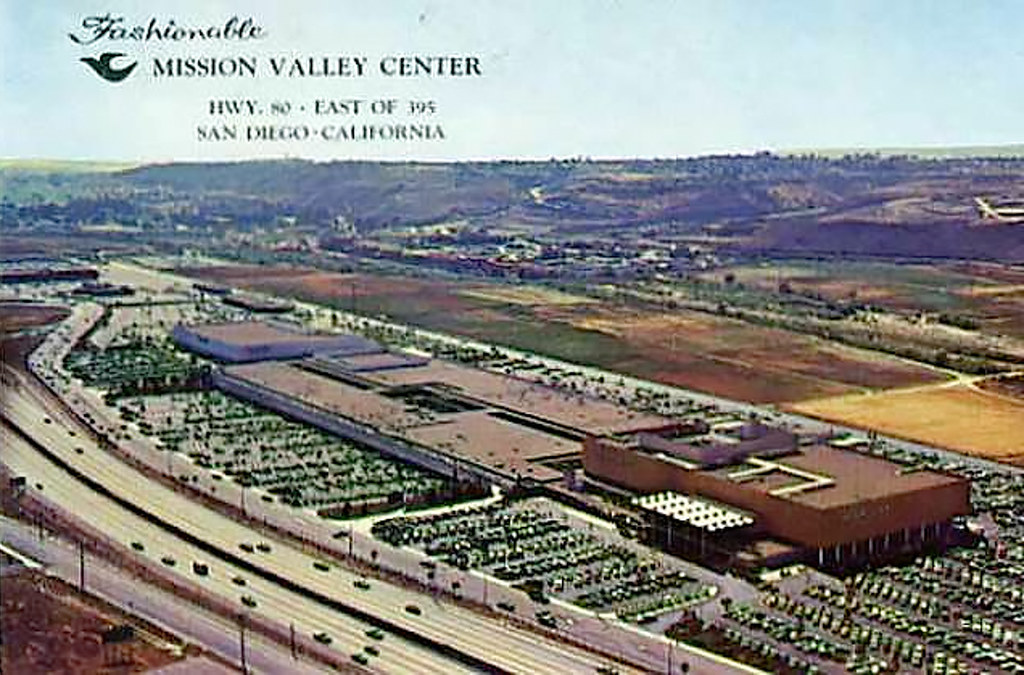 |
| Vintage postcard of Mission Valley Center. |
Mission Valley Center opened to great fanfare on February 20th, 1961.
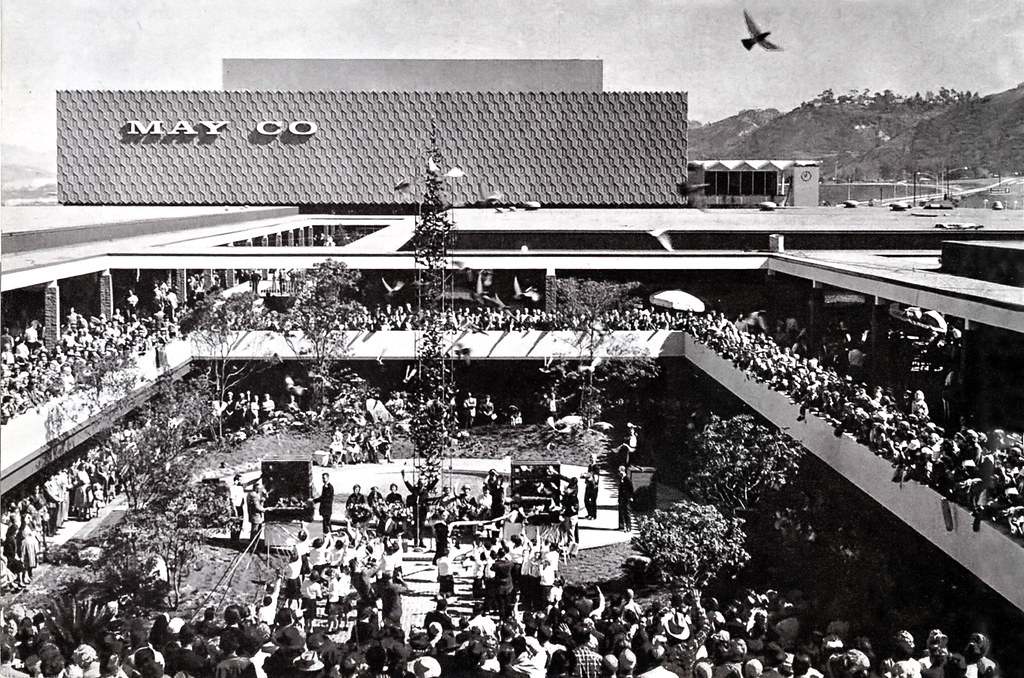 |
| Opening day on Feb. 20th, 1961. The fountain and garden (and children's playground with giant dragon) are no longer there - replaced now with a Ruby's Diner. |
The mall's design was considered state-of-the-art, with parking underneath that provided easy access, and moving ramps to bring people effortlessly to the shops above. It was a big hit.
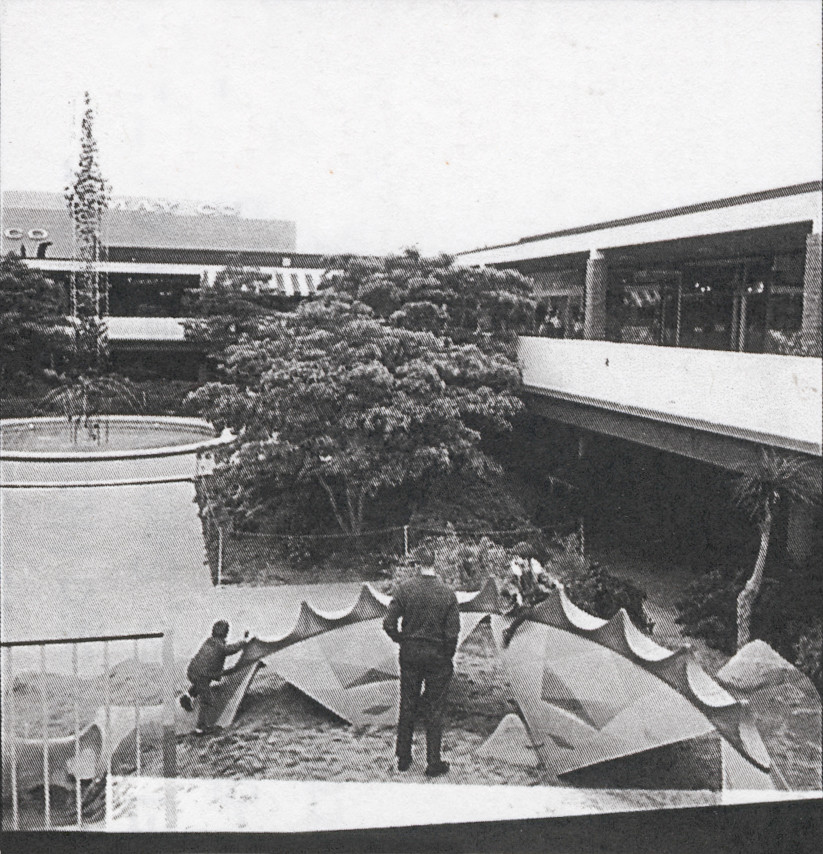 |
| I have fond memories of the dragon playground on the west side of the garden courtyard. |
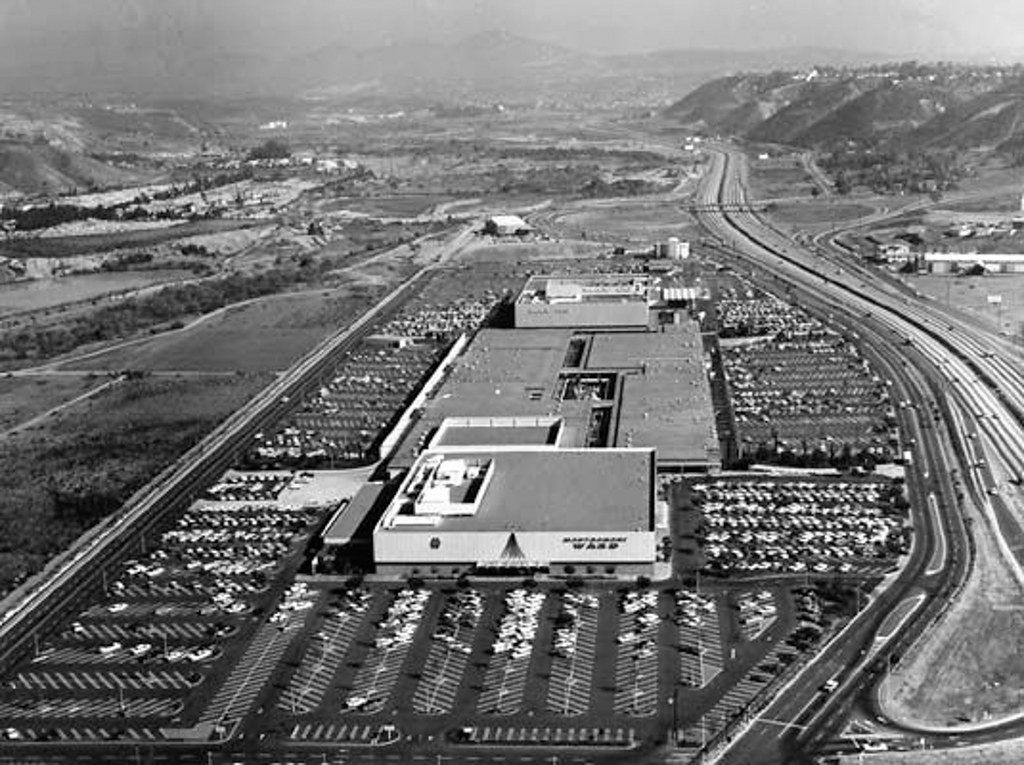 |
| Mission Valley Center when it first opened. Note there was nothing else around then, except the new Interstate 8. The mall was anchored by Montgomery Ward and May Co. |
Given the area's location just north of the city center, Mission Valley was bound to be a prime location for development. But the mall and this May Co. was a catalyst for that development. Many other buildings popped up almost overnight. Plus, the timing of these developments in San Diego coincided with the rising car culture, and the flight of commerce and both affluent and middle class residents from the city centers to the suburbs across America.
Soon, other shops and business began leaving downtown San Diego to relocate to Mission Valley...
...including several ultra-modern, giant, single screen movie theaters...
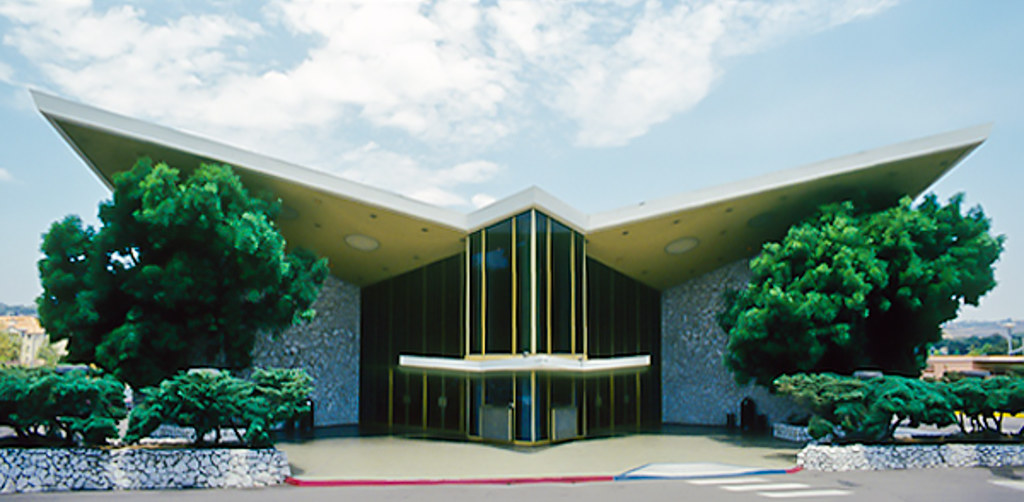 |
| Valley Circle Theater opened in 1966, one of three giant single-screen theaters in Mission Valley. I saw Empire Strikes Back here in 1980. |
 |
| Postcard commemorating Century 21 theater's opening night in 1963. |
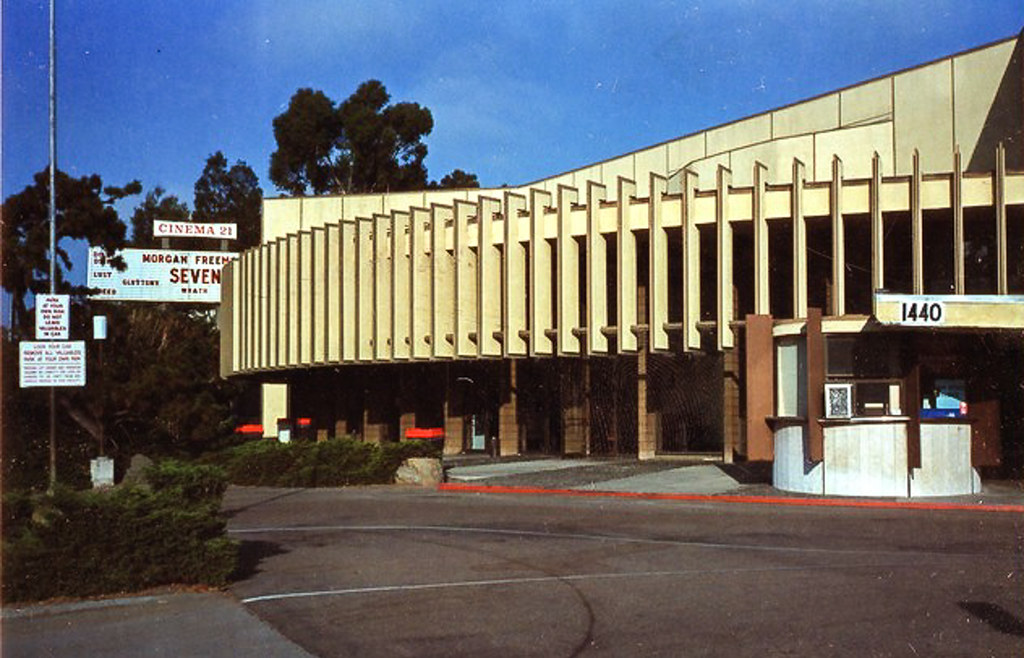 |
| Century 21 Theater in Mission Valley. I saw the premier of Krull here at the Premier in 1983. The theater was torn down in 2003. |
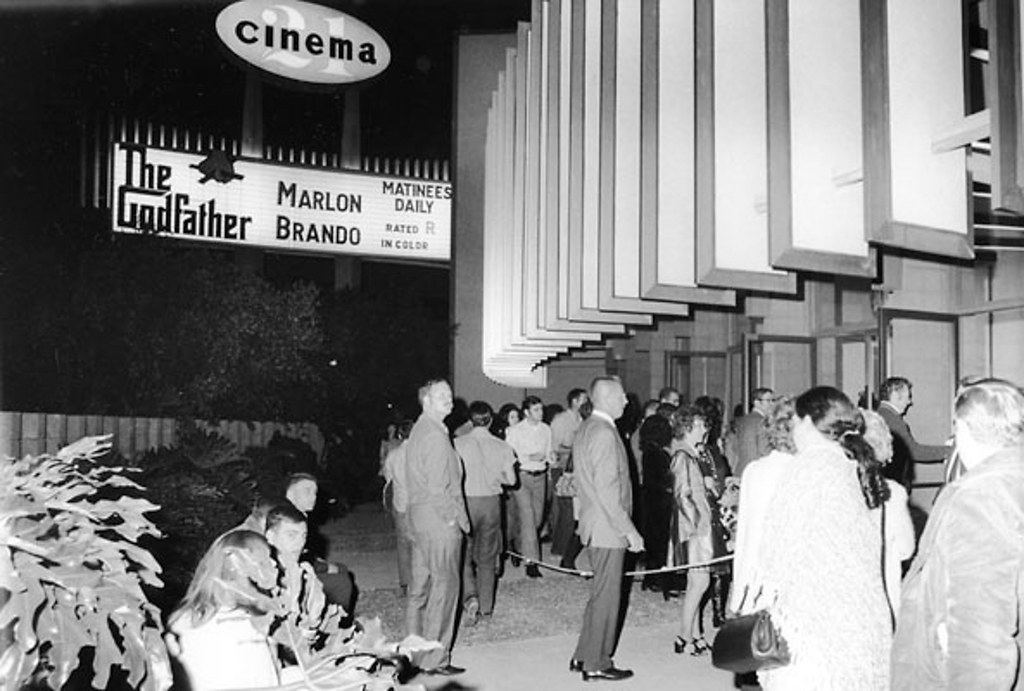 |
| Another view of Century 21 Theater, showing The Godfather in 1972. |
... a second, larger shopping center (this one designed by William Pereira!)...
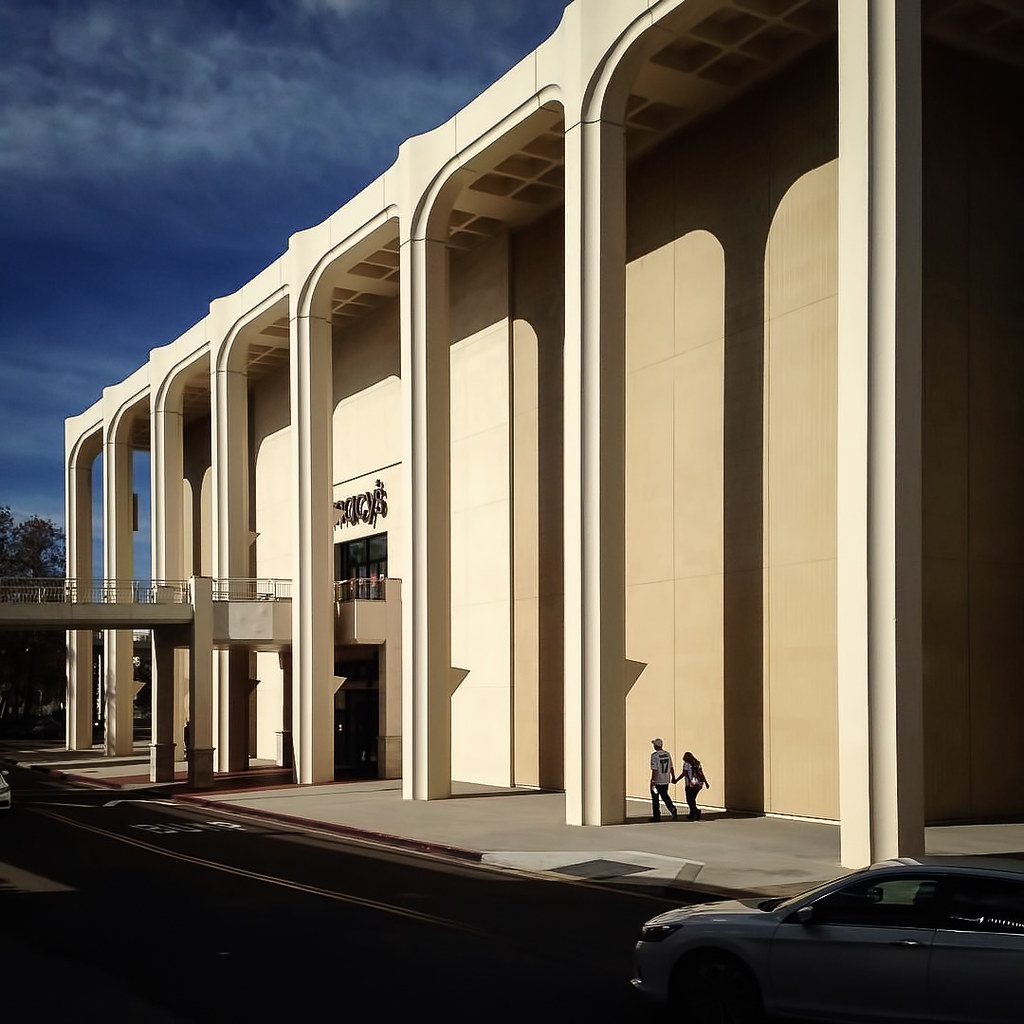 |
| Unfortunately, the Macy's store in Fashion Valley is about all that's left of the William Pereira original designs for this shopping center. Photo ©Darren Bradley |
an amazing bowling alley...
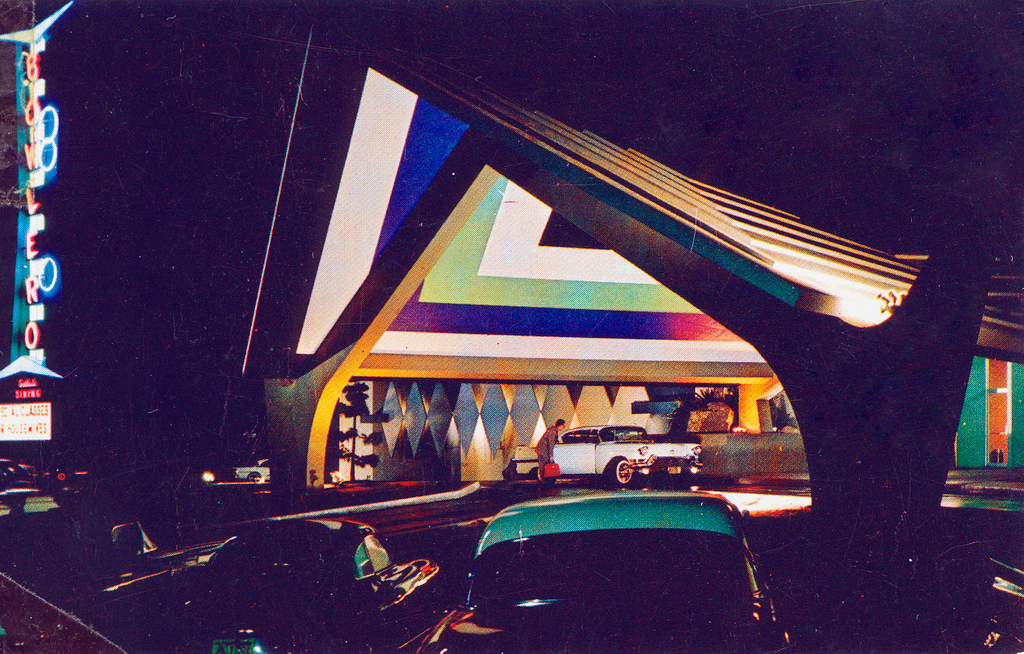 |
| The bowling alley was quite the hotspot for a sophisticated evening out on the town. Vintage postcard. |
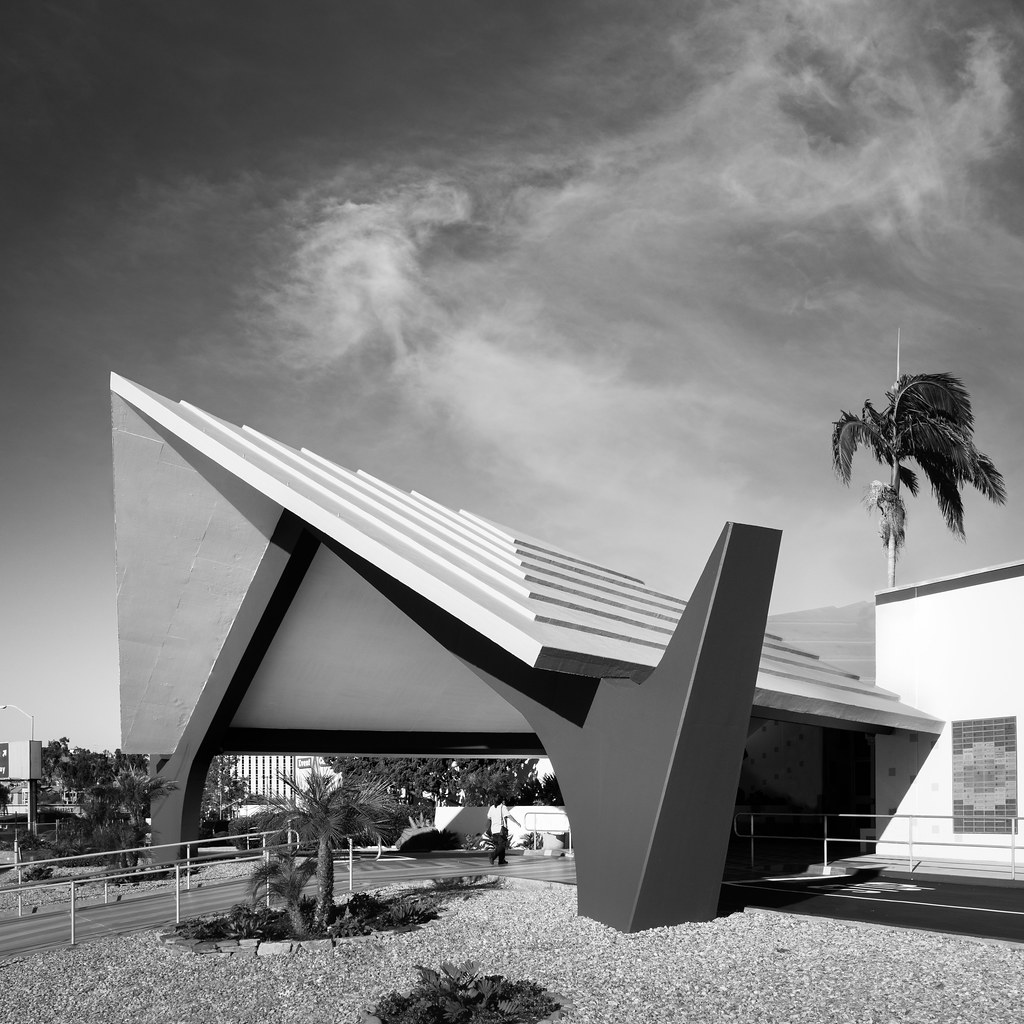 |
| The Bowlero as it looks today. It's a Masonic Lodge now, and a lot more boring. Photo ©Darren Bradley |
all sorts of modern hotels and resorts...
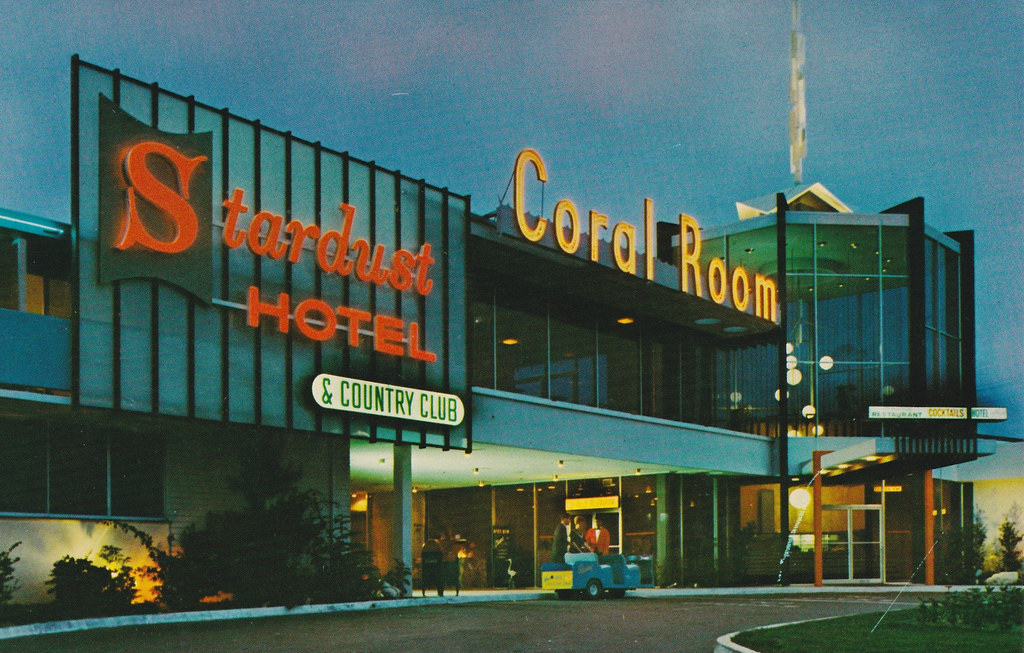 |
| The Stardust is still there, but it's been dumbed down into a bland stucco mess called the Handlery now. There are still some remnants if you care to search them out. |
Even the churches got in on the act...
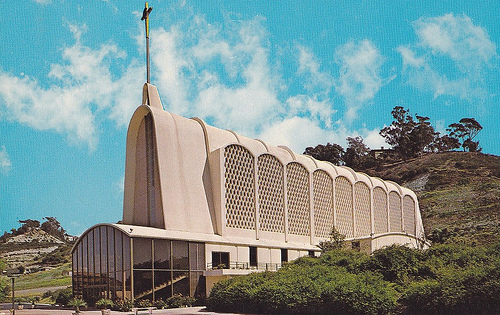 |
| The First United Methodist Church by Reginald Inwood (1960). |
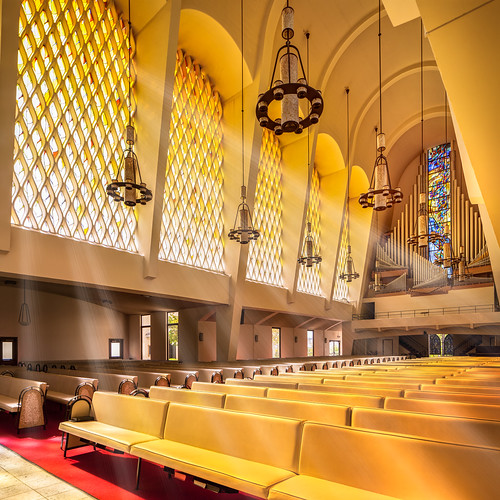 |
| Interior of the First United Methodist Church in Mission Valley. Photo ©Darren Bradley |
... and also the new San Diego Stadium, which hosted both the Padres and the Chargers (replacing Lane Field and Balboa Stadium downtown)...
... and even San Diego's newspaper of record, the San Diego Union (which later merged with the Evening Tribune to become the Union-Tribune).
Mission Valley quickly became a hotbed of Modernist architecture, and soon replaced downtown as the social, cultural, and commercial center of San Diego.
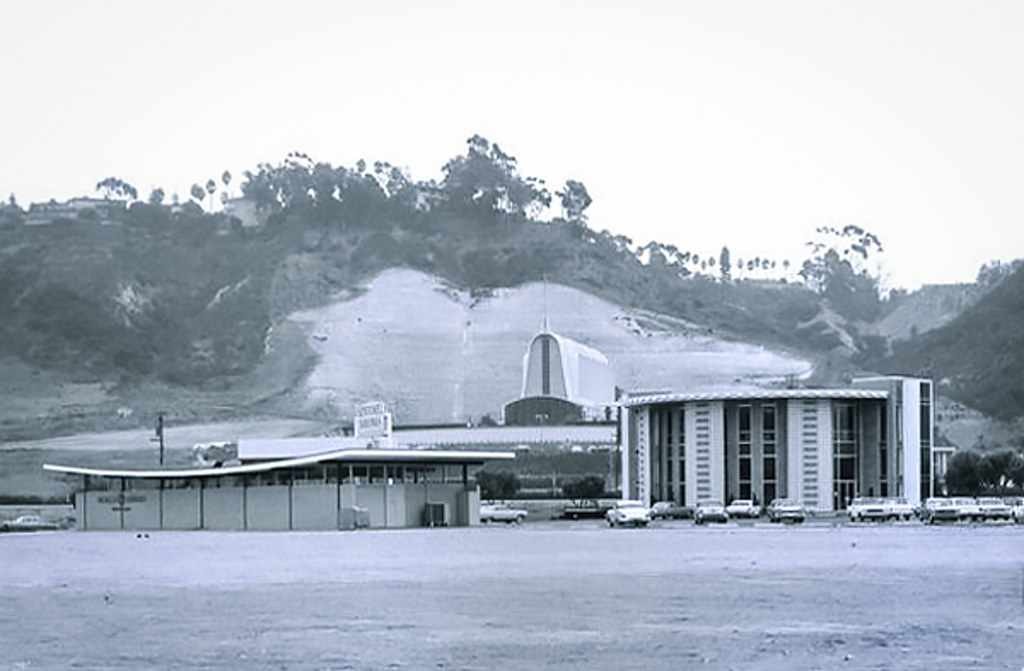 |
| Early days of Mission Valley Modernism. |
But it didn't last very long. By the mid-90s, most of the modernist buildings that had come to define Mission Valley had disappeared - replaced by big box warehouse stores like IKEA and Costco, strip malls, and bland, stucco boxy apartment buildings made to vaguely invoke Spanish or Tuscan architecture.
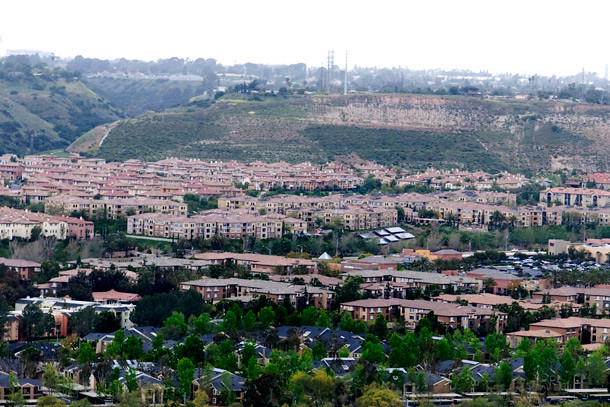 |
| Mission Valley Today. Photo from Voice of San Diego |
Which makes it all the more important that we try to preserve this Macy's building... it's a survivor, and one of the last buildings still standing to remind us of what San Diego's Mission Valley once looked like, and represented.
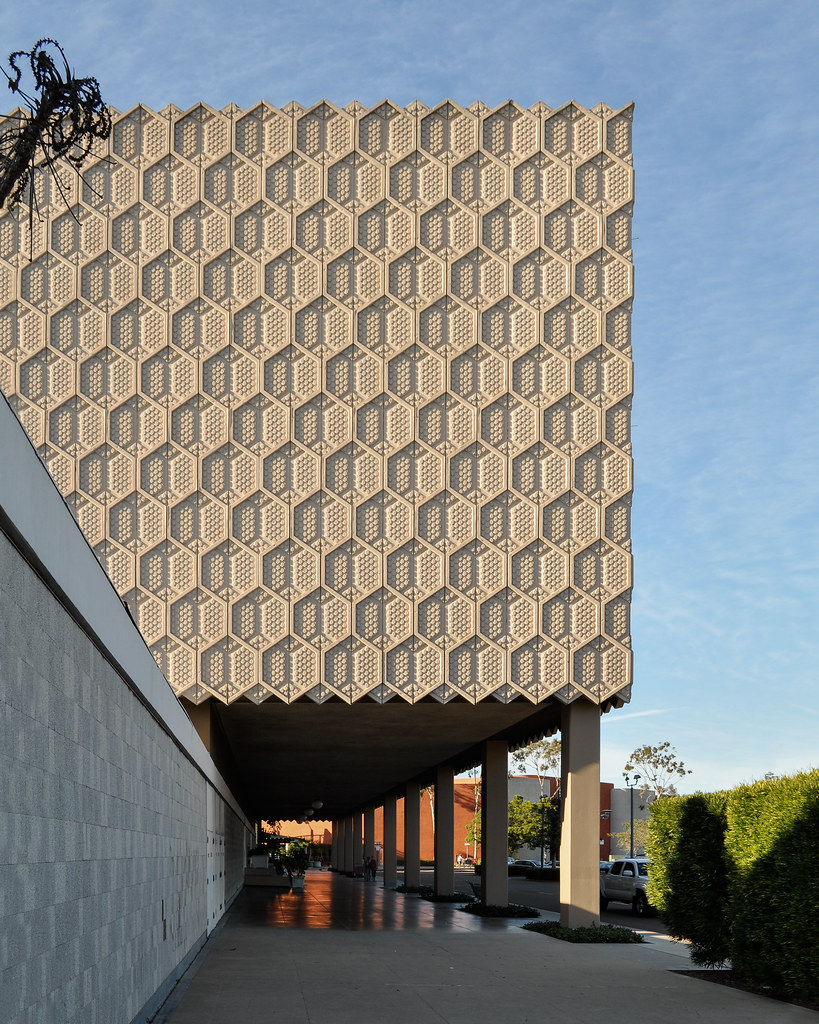 |
| Photo ©Darren Bradley |
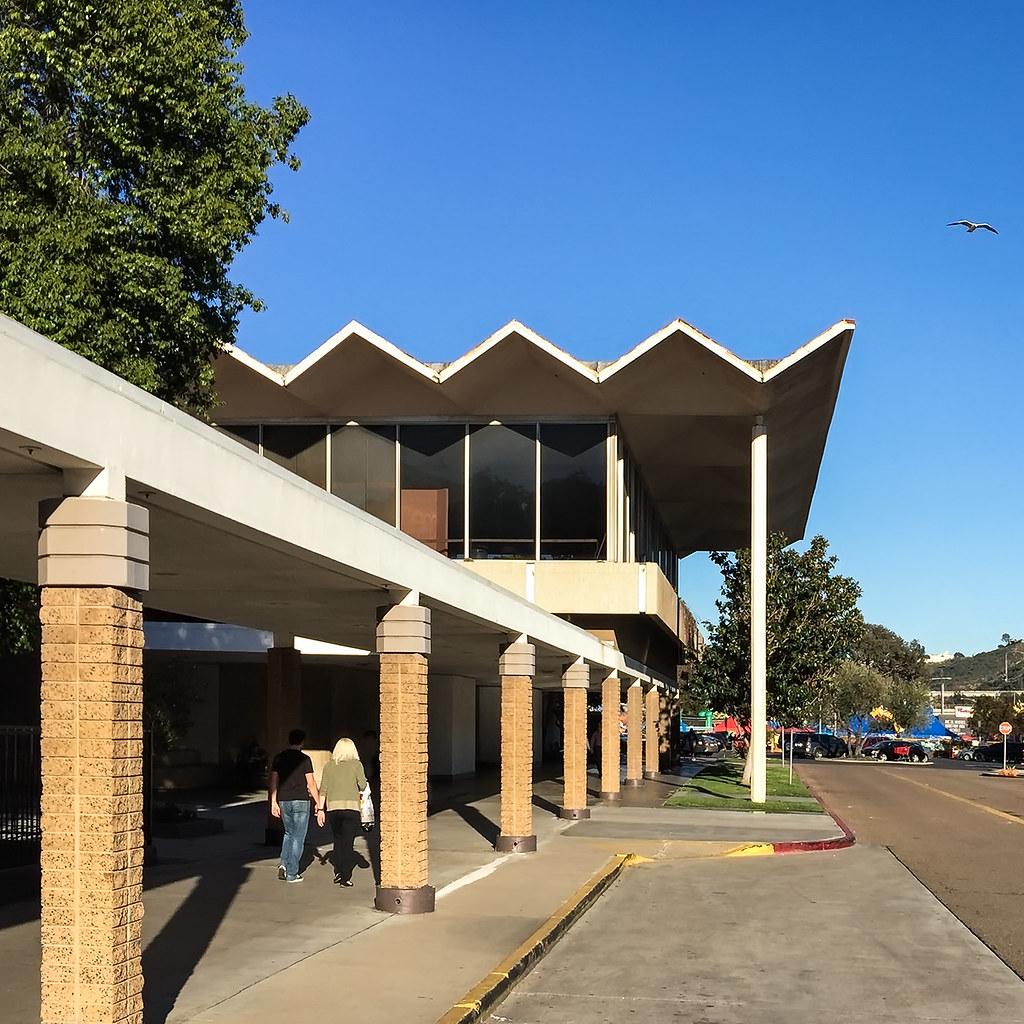 |
| Photo ©Darren Bradley |
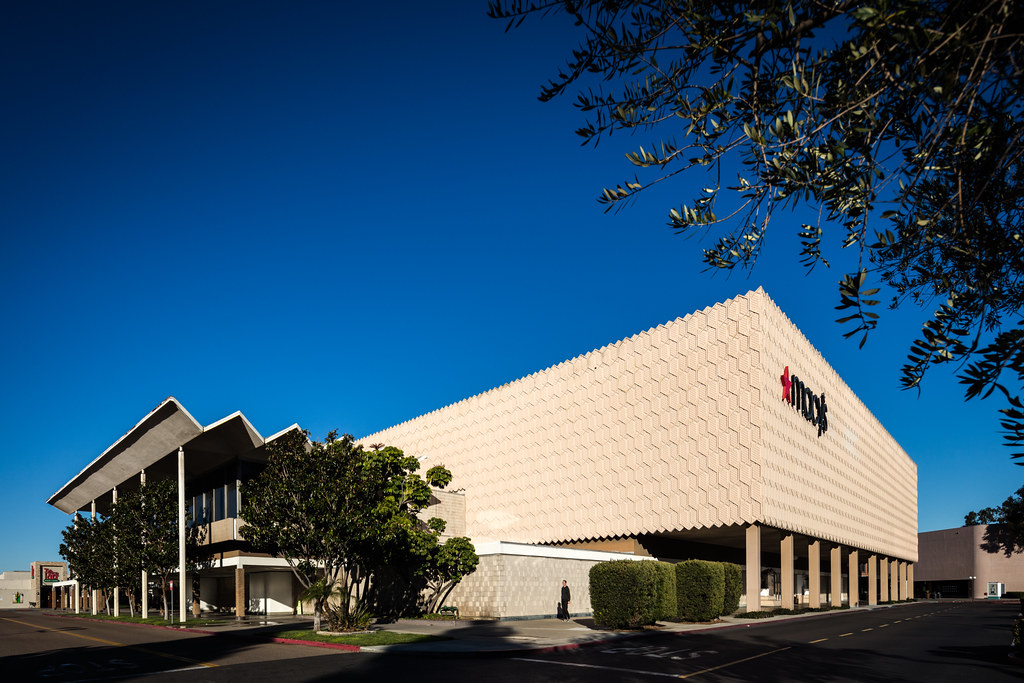 |
| Photo ©Darren Bradley |
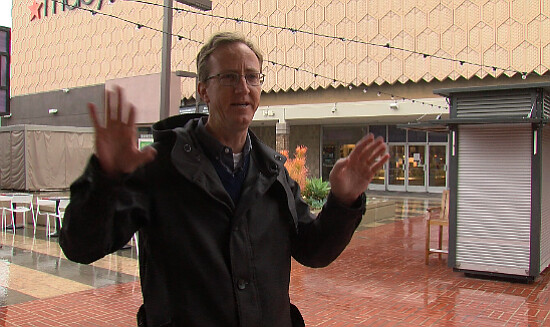
You can see me here:
If you're interested, please write to Westfield and let them know how you feel.

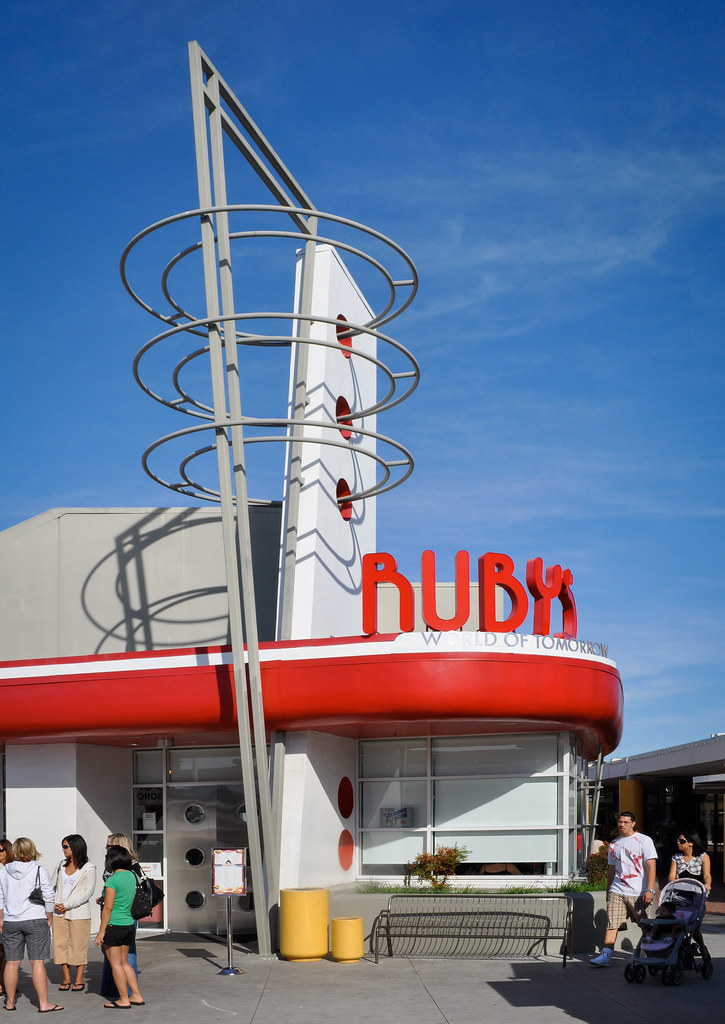
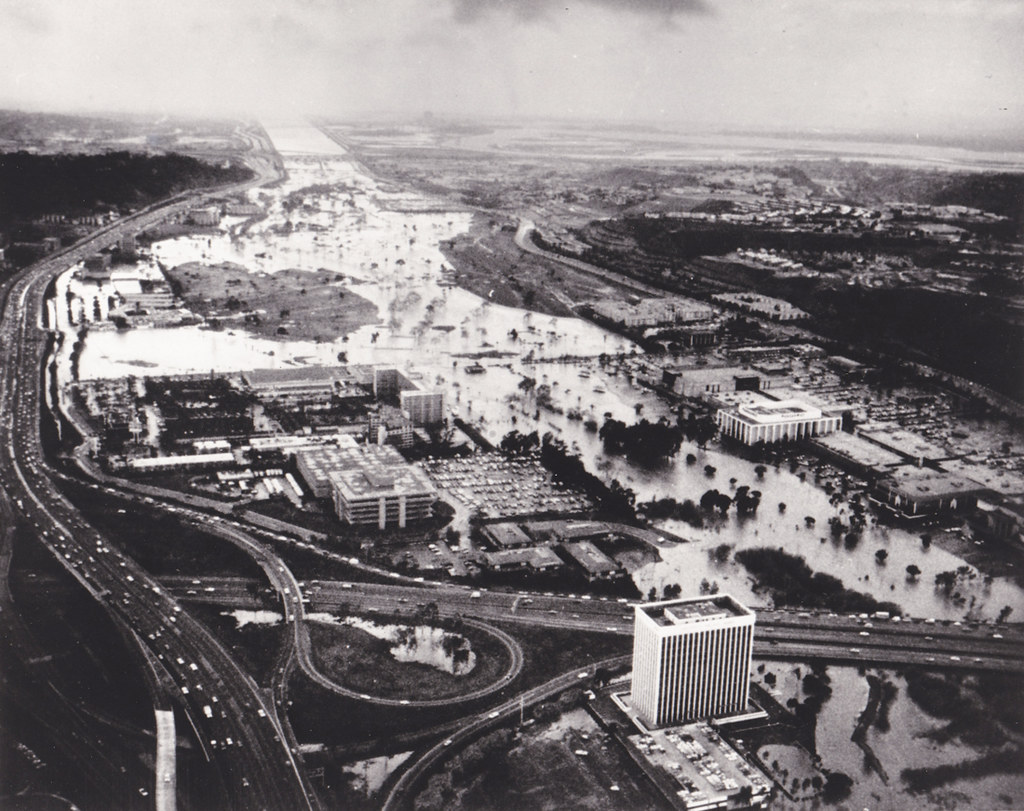
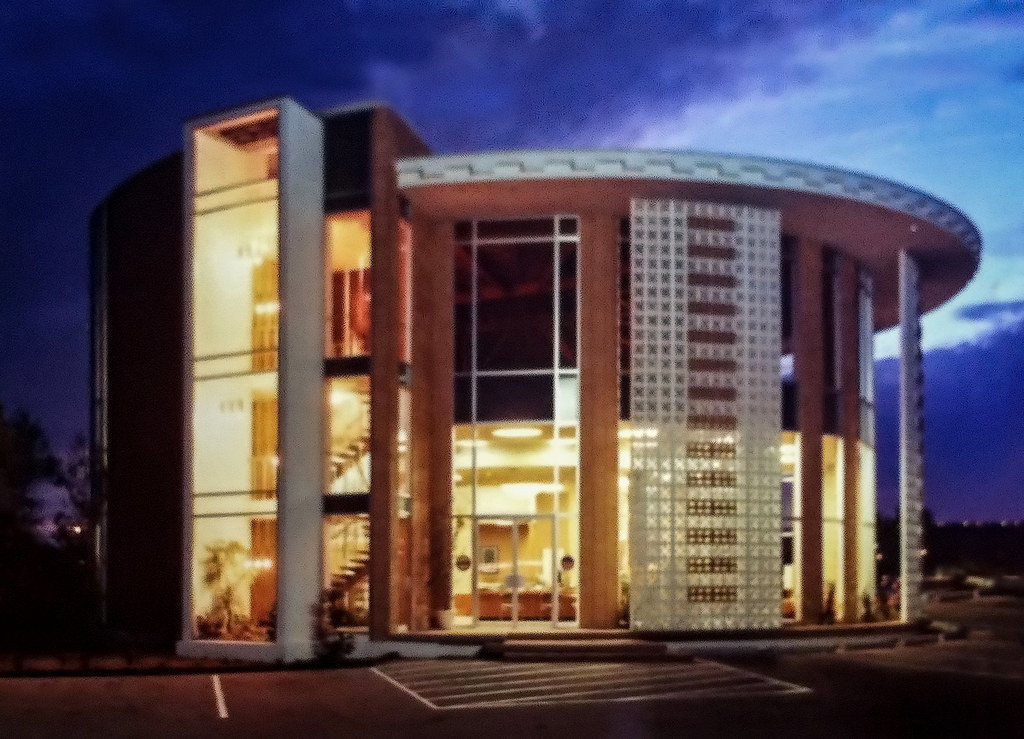
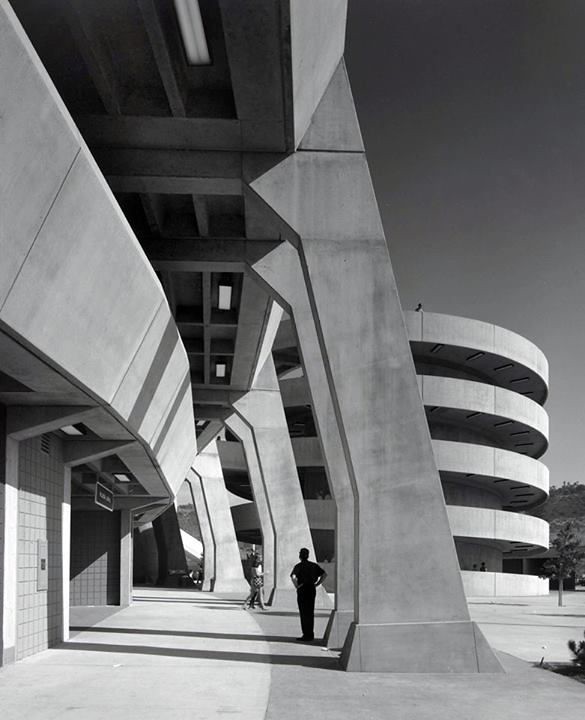
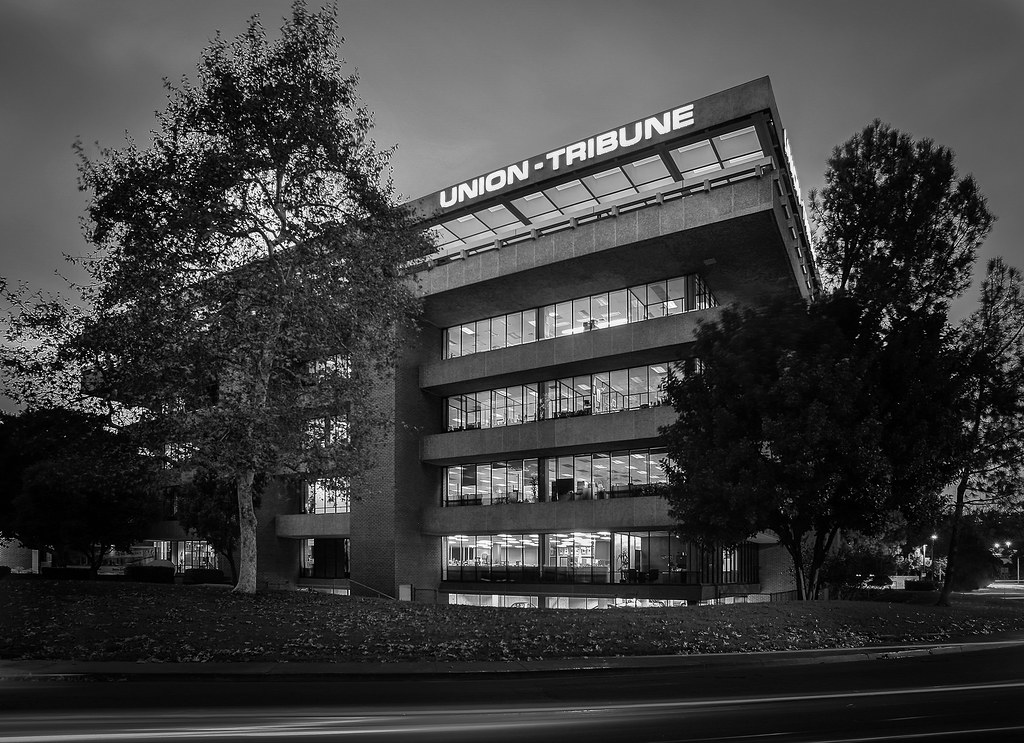
No comments:
Post a Comment